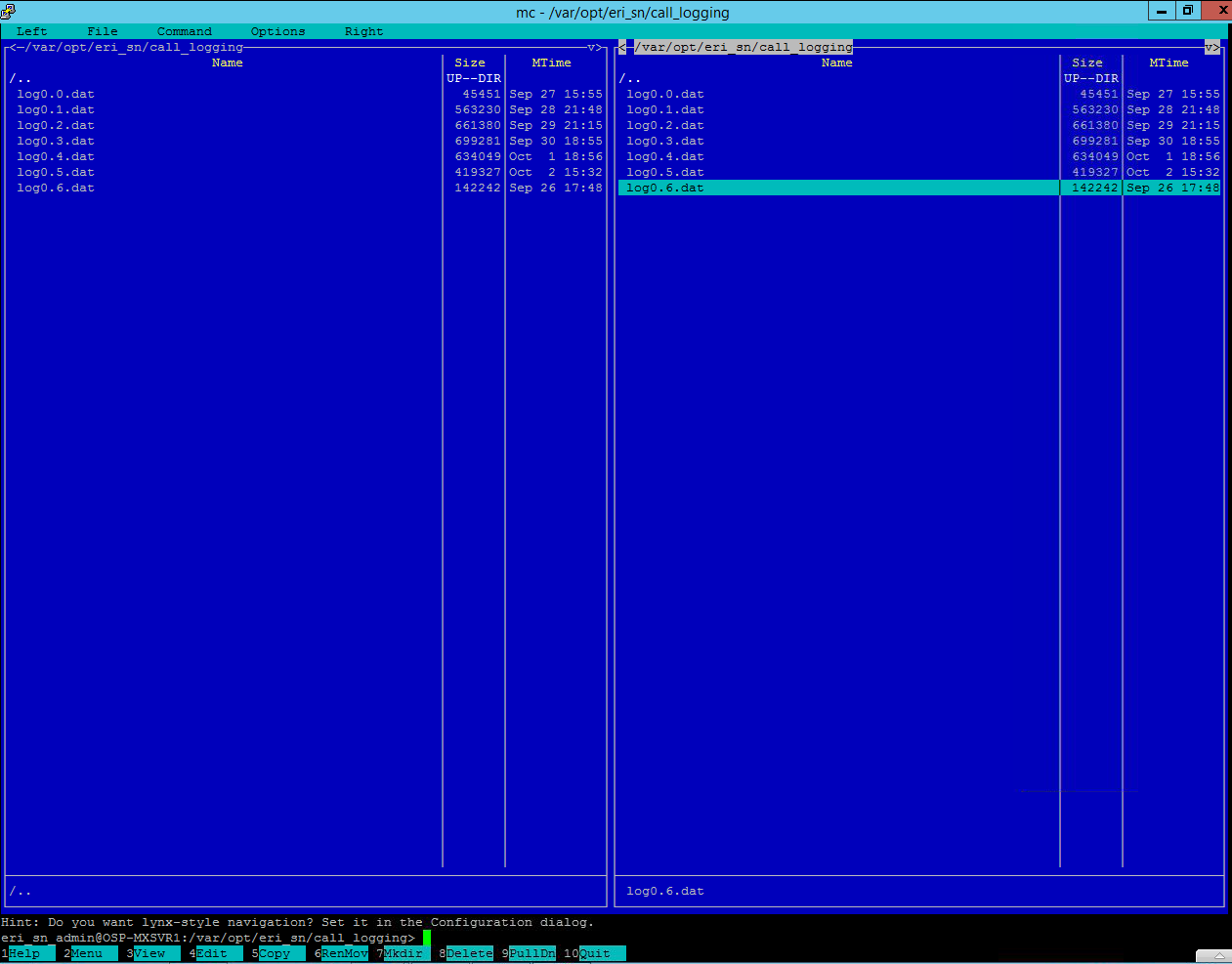These instructions help you configure your Aastra MX-ONE phone system to work with TIM Plus. Contact your system maintainer if you are not familiar with the configuration of your PBX.
Connection Type
Support Files
Required Tasks
Configuring your SMDR output
The MX-One phone system saves the call logging information into a local database, located by default in:
/var/opt/eri_sn/call_logging |

To edit the default path, SSH into each MX-One and use the mc command. You can use the mkdir (key 7) to configure the directory structure as required.
Next, you need to enter the following commands for the primary MX-One (the one that will send the data via IP to TIM Plus):
callinfo_output_set -output 0 -lim 1 -type file -subtype general -local -dbname /var/opt/eri_sn/call_logging/log0 -format ": {stoptime md110date L 4 4}{stoptime md110time L 4 4}{stoptime second 0R 2 2} {duration md110duration L 5 5}; [taxpulses != 0]: {taxpulses R 4 4}; [taxpulses == 0]: ; {conditionCodeUserDefined L 3 3} {accesscode1 R 5 5}{accesscode2 R 5 5}; [conditionCodePos == 17]: {chargedNumber R 20 20}; [conditionCodePos != 17]: {dialednumber R 20 20}; {callingnumber L 20 20} {accountcode L 15 15} {cilcode L 6 6} {queueTimeCounter 0R 3 3} {ringTimeCounter 0R 3 3} {ogTrnkId R 10 10} {incTrnkId R 10 10} {connectedNumber R 16 16}{return}{newline};" -eol NL -record call -localtime |
callinfo_output_set -output 1 -lim 1 -type tcp -subtype general -server 192.168.0.1 -port 9000 -format ": {stoptime md110date L 4 4}{stoptime md110time L 4 4}{stoptime second 0R 2 2} {duration md110duration L 5 5}; [taxpulses != 0]: {taxpulses R 4 4}; [taxpulses == 0]: ; {conditionCodeUserDefined L 3 3} {accesscode1 R 5 5}{accesscode2 R 5 5}; [conditionCodePos == 17]: {chargedNumber R 20 20}; [conditionCodePos != 17]: {dialednumber R 20 20}; {callingnumber L 20 20} {accountcode L 15 15} {cilcode L 6 6} {queueTimeCounter 0R 3 3} {ringTimeCounter 0R 3 3} {ogTrnkId R 10 10} {incTrnkId R 10 10} {connectedNumber R 16 16}{return}{newline};" -eol NL -record call -localtime |
The server IP address specified above will be the IP address of the TIM Plus machine. The port number can be set to any free TCP port, but we would recommend one in the 9000 range. |
callinfo_output_set -output 2 -lim 1 -type file -subtype none -record call -utccallinfo_output_set -output 3 -lim 1 -type file -subtype none -record call -utc callinfo_output_set -output 4 -lim 1 -type file -subtype none -record call -utc callinfo_output_set -output 5 -lim 1 -type file -subtype none -record call -utc callinfo_output_set -output 6 -lim 1 -type file -subtype none -record call -utc callinfo_output_set -output 7 -lim 1 -type file -subtype none -record call -utc callinfo_output_set -output 8 -lim 1 -type file -subtype none -record call -utc callinfo_output_set -output 9 -lim 1 -type file -subtype none -record call -utc |
To send the data, add the following two commands for the primary MX-One:
callinfo_status_set -lim 1 -output 0 -state oncallinfo_status_set -lim 1 -output 1 -state on |
For each additional MX-One in the cluster, the following commands need to be entered, applying lim 2, 3, 4...n accordingly.
callinfo_output_set -output 0 -lim 2 -type file -subtype general -local -dbname /var/opt/eri_sn/call_logging/log0 -format ": {stoptime md110date L 4 4}{stoptime md110time L 4 4}{stoptime second 0R 2 2} {duration md110duration L 5 5}; [taxpulses != 0]: {taxpulses R 4 4}; [taxpulses == 0]: ; {conditionCodeUserDefined L 3 3} {accesscode1 R 5 5}{accesscode2 R 5 5}; [conditionCodePos == 17]: {chargedNumber R 20 20}; [conditionCodePos != 17]: {dialednumber R 20 20}; {callingnumber L 20 20} {accountcode L 15 15} {cilcode L 6 6} {queueTimeCounter 0R 3 3} {ringTimeCounter 0R 3 3} {ogTrnkId R 10 10} {incTrnkId R 10 10} {connectedNumber R 16 16}{return}{newline};" -eol NL -record call -localtime callinfo_output_set -output 1 -lim 2 -type file -subtype none -record call -utc callinfo_output_set -output 2 -lim 2 -type file -subtype none -record call -utc callinfo_output_set -output 3 -lim 2 -type file -subtype none -record call -utc callinfo_output_set -output 4 -lim 2 -type file -subtype none -record call -utc callinfo_output_set -output 5 -lim 2 -type file -subtype none -record call -utc callinfo_output_set -output 6 -lim 2 -type file -subtype none -record call -utc callinfo_output_set -output 7 -lim 2 -type file -subtype none -record call -utc callinfo_output_set -output 8 -lim 2 -type file -subtype none -record call -utc callinfo_output_set -output 9 -lim 2 -type file -subtype none -record call -utc |
callinfo_status_set -lim 2 -forward 1 -state on |
Configuring TIM Plus
Follow the steps below to configure TIM Plus to listen for SMDR data from your MX-One:
- Click on the tab.
- Choose the site you want to configure and click .
- In the Site Properties window, select Aastra MX-ONE - BC13 from the PBX model drop-down list.
- In the Connection method field, select Listen for connections from PBX from the drop-down list.
- Leave the Host field blank.
- In the Port field, enter the port number you have configured in the phone system.
- Click on the button to apply the settings.